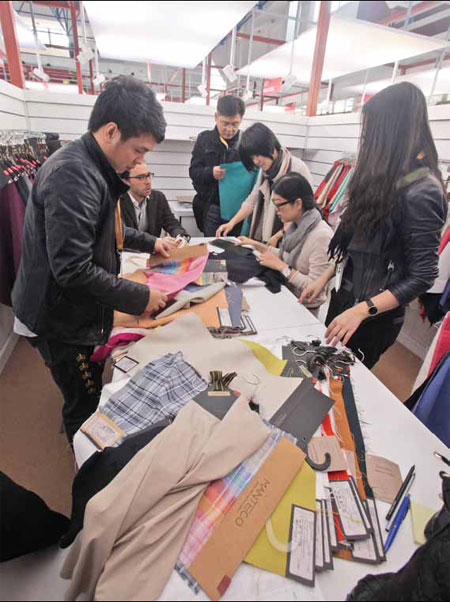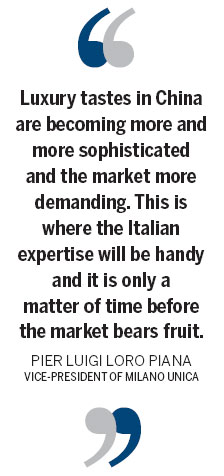Italian fabric takes shape in China

Growing Chinese high-end luxury market emerging as beacon of hope for European fabric makers

Chinese clothing manufacturers check on Italian fabrics at the Intertextile Beijing Apparel Fabrics Expo. [Provided to China Daily]
|
When Lanificio F.lli Cerruti dal 1881 entered China 20 years ago, its biggest challenge was to find customers who could afford its expensive range of menswear fabrics.
But money is no longer an issue for the Italian fabric fashion house and fabric maker as wealthy Chinese are fast developing a taste for high-end Italian-styled clothing.
"Over the past five to six years, the number of Chinese consumers who are appreciating the quality of Italian fabric has been steadily growing," says Daniele Sanzeni, CEO and managing director of the privately owned textile company, during a recent visit to Beijing.
"For many Chinese clothing manufacturers, Italian-designed fabrics can add more value to their products. This can be reflected in the details of the pocket or in the stitching of the sleeve."
Lanificio Cerruti is among a growing number of Italian fabric makers that are cashing in on booming exports to China, even as local textile firms are looking to establish a presence in the high-end market.
Fabric exports from Italy to China grew 27.2 percent last year from 2010 to 203 million euros, making China the second-largest destination for Italian fabrics, according to information provided by Milano Unica, an international textile association.
Silvio Albini, president of Milano Unica, says that nearly 95 Italian fabric makers participated in the recently held Intertextile Beijing Apparel Fabrics Expo.
"The strong demand is an indication of the growing appetite of the Chinese consumers for luxury goods," Albini says. "A suit that is made of Italian fabric will make a big difference, improving the looks, quality and overall value of the item and thus helping Chinese clothing makers move up the value chain and onto the high-end market."
In a testament to Chinese consumption, the market in the Chinese mainland rose from $9.3 billion (7.1 billion euros) in 2009 to $16.9 billion (12.9 billion euros) in 2011 only in the personal luxury goods sector, says a recent report from the Boston-based research firm Bain & Company, a US management consulting firm. It forecasts China will become the world's largest market for luxury goods by 2015.
"The fabrics made in China is acceptable for some products, but not reliable for high-end suits," says Antonino Laspina, director of the Italian Trade Commission (ICE) in China. "Important buyers from the US and Japan come to China and say that the quality of Chinese manufacturing is fine. But the demand for high-quality pieces (clothing) can only be satisfied with Italian fabrics."
Sanzeni says his company specializes in wool and fiber fabrics and its tag is a big draw for Chinese suit makers who are keen on tapping the high-end market.
Italian fashion house Cerruti had a presence in China earlier, and was known for its woolen suits. However, the Italian company sold its garment business to Hong Kong-based Trinity, a subsidiary of Li & Fung Ltd, for a reported 53 million euros in 2010. Now it operates only its textile company, catering to a bevy of designers, retailers and suit makers in China, including Delure, Ports and Baoxiniao, all big names with thousands of stores in China.
Many Chinese clothing makers, who were previously engaged in contract manufacturing for exports, have in recent years created their own brands. Not only have they adopted Italian-sounding names but also import Italian materials, trying to use their expertise to crack the high-end market.
Li Guomin, president of a Jiangsu-based menswear manufacturer, which used to be involved in OEM, now has his own brand called "Sucieta". Products under the brand have been made with Italian fabrics over the last few years.
"Fabric plays a crucial role in our business, and a little difference in material can change the whole image of a product," he says.

"Italy is a major manufacturing base for fabrics and leads in fashion trends. Using Italian fabric helps us make inroads into the high-end market, despite the higher prices."
While some companies are trying to create an Italian image from inside out, Youngor, the Shanghai-listed fashion chain with more than 2,000 boutique stores, continues to use its own brand, but using Italian fabrics only for part of its limited collection.
Youngor Group in East China's Zhejiang province has been a major client for Cerruti for years.
"Over 10 percent of our dress materials are imported from Italy and they are used in the high-end menswear collections on display in our boutique stores in cities like Shanghai, Beijing and Guangzhou," says Xu Qigang, managing director of Youngor Group.
"It is important for a strong Chinese luxury brand to have a foreign touch and that is the reason why we are teaming up with some international companies."
The fact that many Chinese companies are launching high-end brands in association with Italian firms is a strong indication of the changes the world's second-largest economy is bringing to Italian fabric makers.
Hit hard by the economic crisis, many fabric makers have suffered heavy losses in traditional markets like the US and Europe. Emerging markets like China and India are now considered saviors for Italian textile makers.
Lanificio F.lli Cerruti dal 1881 saw its revenue rise 20 percent to 5 million euros in China last year, while the growth in its traditional European markets was just 10 percent. Loro Piana, one of the largest textile and garment companies in Italy, also reported growth of 30 percent in the Chinese market, well above the 17 percent in the global market.
Data from ICE shows that China imported around $145 million worth of wool fabrics from Italy in 2010, accounting for 33 percent of the total value of imported wool fabrics, up from 31 percent in 2009.
"China has become one of the most important markets for us with total revenue of more than 50 million euros last year," says Pier Luigi Loro Piana, vice-president of Milano Unica and CEO of luxury company Loro Piana.
"The rush to keep pace with the country's demand requires us to improve with extensive knowledge and unique presence.
"Luxury tastes in China are becoming more and more sophisticated and the market more demanding. This is where the Italian expertise will be handy and it is only a matter of time before the market bears fruit."
lvchang@chinadaily.com.cn
Today's Top News
- Xi calls for promoting volunteer spirit to serve national rejuvenation
- Xi chairs CPC meeting to review report on central discipline inspection
- Reunification will only make Taiwan better
- Outline of Xi's thought on strengthening military published
- Targeted action plan to unleash consumption momentum
- Separatist plans of Lai slammed






























